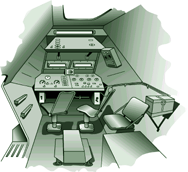
 The
specialized support vehicles and efficient supply methods of the V2 contributed
greatly to the successful operational record compiled by German rocket
troops. The firing of up to 8-12 missiles per day by some batteries showed
the ruggedness in ingenuity of these vehicles. Some vehicles were adapted
from existing Wehrmacht equipment and proved quite compatible.
The
specialized support vehicles and efficient supply methods of the V2 contributed
greatly to the successful operational record compiled by German rocket
troops. The firing of up to 8-12 missiles per day by some batteries showed
the ruggedness in ingenuity of these vehicles. Some vehicles were adapted
from existing Wehrmacht equipment and proved quite compatible.
![]()
Feuerleitpanzerfahrzeug
für V-2 Raketen auf Zugkraftwagen 8-ton
Zugkraftwagen 8t - Sonder Kraftfahrzeug
– Special Motorvehicle (Sd.Kfz.7/3) half-tracked prime-mover, powered by
the Maybach HL62TUK, was converted to control post vehicles for rocket
launching units. The rear of the Feuerleitpanzer was mounted with an armored
superstructure to house the guidance and radio equipment and to protect
the crew of 3 men from the blast and explosion. The vehicle also sometimes
towed the mobile firing platform used to launch the rocket (Abschussplattform).
 |
 |
||
 |
 |












































